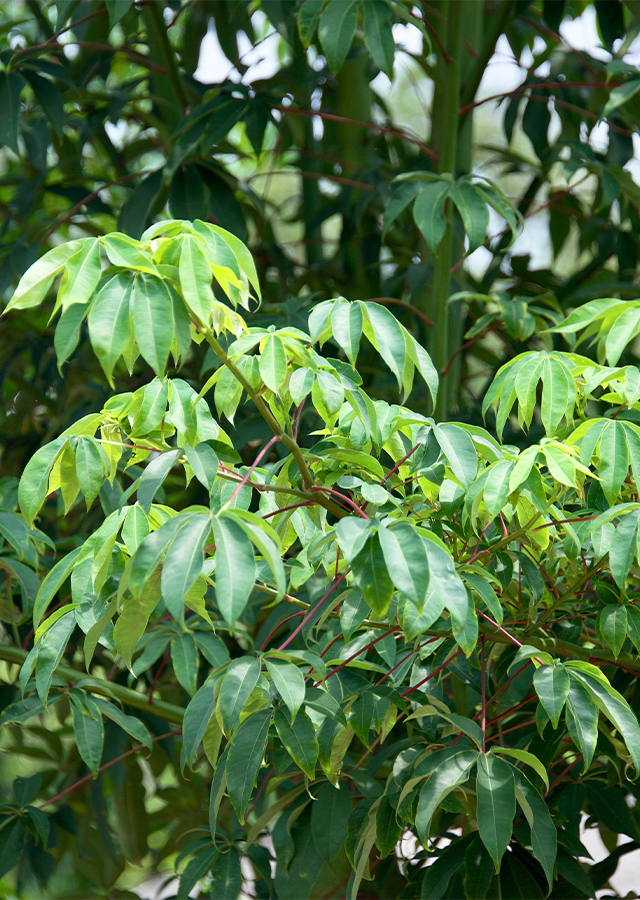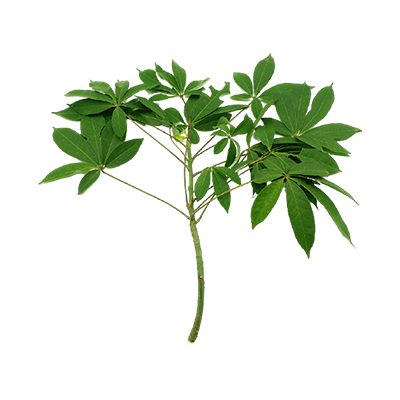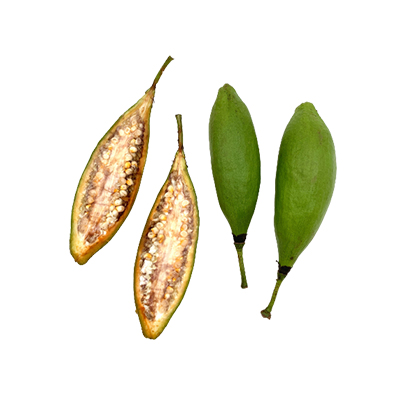Kapok
Ceiba pentandra (L.) Gaertn.
Malvaceae
Location in our garden
Orchard



Synonym
Bombax cumanense Kunth
Bombax mompoxense Kunth
Bombax occidentale Spreng.
Habitus
Trees. Kapok is a deciduous tree, grows up to 70 m, in cultivation usually 18-30 m tall. Roots spreading quite horizontally, 10 m or longer, in the upper 40-80 cm of the soil. Trunk with or without buttresses, forked or unforked, spiny or spineless.
Part Used
Leaves
Seeds
Bark
Flowers
Fruit
Roots
Stem
Growing Requirements
Full Sunshine
Habitat
Forest
Overview
Kapok is native to tropical America and Africa, and is mostly cultivated in South-East Asia for its seed fiber. It is especially valued for its fibre, but also supplies foods, medicines and many commodities. The tree is widely cultivated and semi-cultivated throughout the tropics and has become naturalized in many areas. Kapok is a fast growing tree and becomes productive within 4 to 5 years.
Vernacular Names
Kabuk-abu (Malaysia), Balios (Philippines), Gao (Vietnamese), Arbre à kapock (French), Mosmote (Spanish), Arvore-da-la (Brazilian), Kapokboom (Afrikaan), Nun (Thailand), Koo (Cambodia), Kapuk Randu (Indonesia).
Agroecology
It mostly occurs in secondary forest. It is generally found in areas where annual rainfall ranges from 750 to 3,000 mm at elevations up to 1,200 m. It grows best in areas where annual daytime temperatures are within the range 17-38 °C, but can tolerate 12-40 °C. Prefers a sunny position in a fertile, deep, moisture-retentive but well-drained loamy soil also a position sheltered from strong winds.
Morphology
- Stem - branches whorled, dimorphic, whorls usually of 3 branches, horizontally or ascending.
- Leaves - alternate, digitately compound; petiole 7-25 cm long; leaflets 5-11, oblong-lanceolate, 5-16 cm × 2-4 cm, glabrous.
- Flowers - axillary fascicles, hanging, actinomorphic, bisexual, calyxcampanulate, glabrous outside, petals oblong-obovate, united at base, usually dirty white with foetid milky smell, glabrous inside and densely silky outside.
- Fruits - ellipsoidal, leathery, pendulous capsule, 7.5-30 cm × 3-7.5 cm, turning brown when ripe, dehiscing with 5 valves ("shells") or indehiscent, many-seeded.
- Seeds - obovoid, 4–6 mm in diameter, dark brown, embedded in copious, white, pale yellow or grey silky wool.
- Roots - tap root with a lot of lateral roots.
Cultivation
- Propagated by seeds - sown as soon as ripe. Seeds germinate within 3 days after sowing. In 6 months the young plants reach a height of 1 m.
- Propagated by stems cuttings.
Chemical Constituents
Phenolic compounds, alkaloids, flavonoids, tannins, saponins, phytat acid, TUI (trypsin inhibitor), HUI (hemagglutinin inhibitor), oksalat acid, palmitat acid, linoleat acid. The seeds and the oil contain cyclopropenoid fatty acids such as malvalic acid (7 - 8%) and sterculic acid (3%).
Traditional Medicinal Uses
- The leaves are used in the treatment of scabies, diarrhoea, coughs,hoarse throats, fatigue and lumbago.
- The flowers are emollient. They are used as a remedy for constipation.
- Young leaves are warmed and mixed with palm oil to be eaten as a remedy for heart problems. Applied externally, the pounded leaves are used as a dressing on sores, sprains, tumours, abscesses, whitlows etc.
- The bark and the leaves are used in the treatment of bronchialcongestion. Externally, they are used in baths to treat fevers and headaches.
- A decoction of the stem bark is taken to treat stomach problems, diarrhoea, hernia, gonorrhoea, heart trouble, oedema, fever, asthma and rickets.
- A decoction of the boiled roots is used to treat oedema, diarrhoea,dysentery, dysmenorrhoea, and hypertension.
- The powdered fruit is taken with water as a remedy for intestinal parasites and stomach-ache.
- The seed oil is rubbed in to affected areas to relieve rheumatism, and isalso applied to heal wounds.
- The fruits are the source of the kapok fibre used for stuffing (e.g. mattresses, pillows, upholstery, protective clothing), and for thermal and acoustic insulation.
Part Used
Reference Sources
- Feedipedia. (2019). Kapok (Ceiba pentandra). https://www.feedipedia.org/node/48. (Accessed 23-02-2021).
- Fern, K. (2019). Useful Tropical Plants. Ceiba pentandra. http://tropical.theferns.info/viewtropical.php?id=Ceiba+pentandra. (Accessed 23-02-2021).
- Health Benefit Times. (2021). Kapok (Ceiba pentandra). https://www.healthbenefitstimes.com/know-about-kapok/. (Accessed 20-04-2021).
- Pl@nt Use. (2020). Ceiba pentandra (PROSEA). https://uses.plantnet-project.org/en/Ceiba_pentandra_(PROSEA). (Accessed 23-02-2021).




